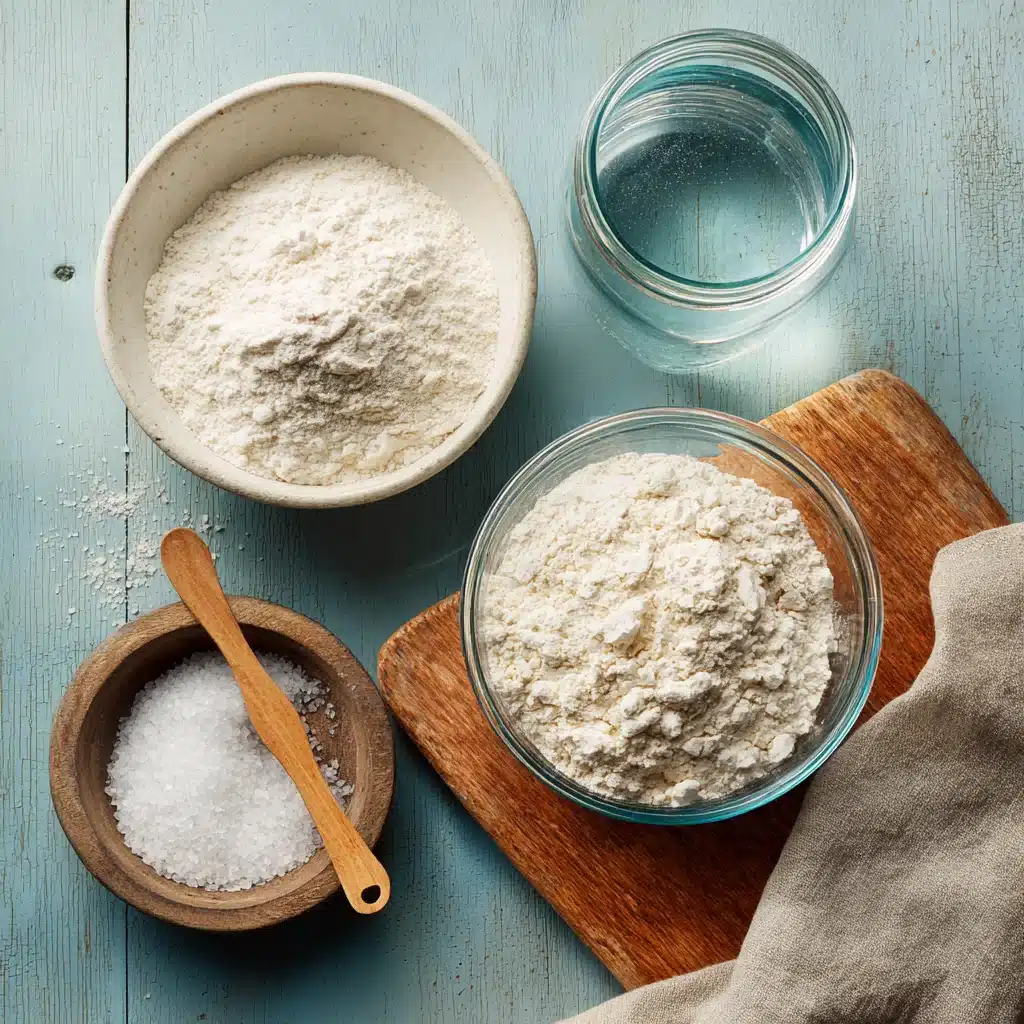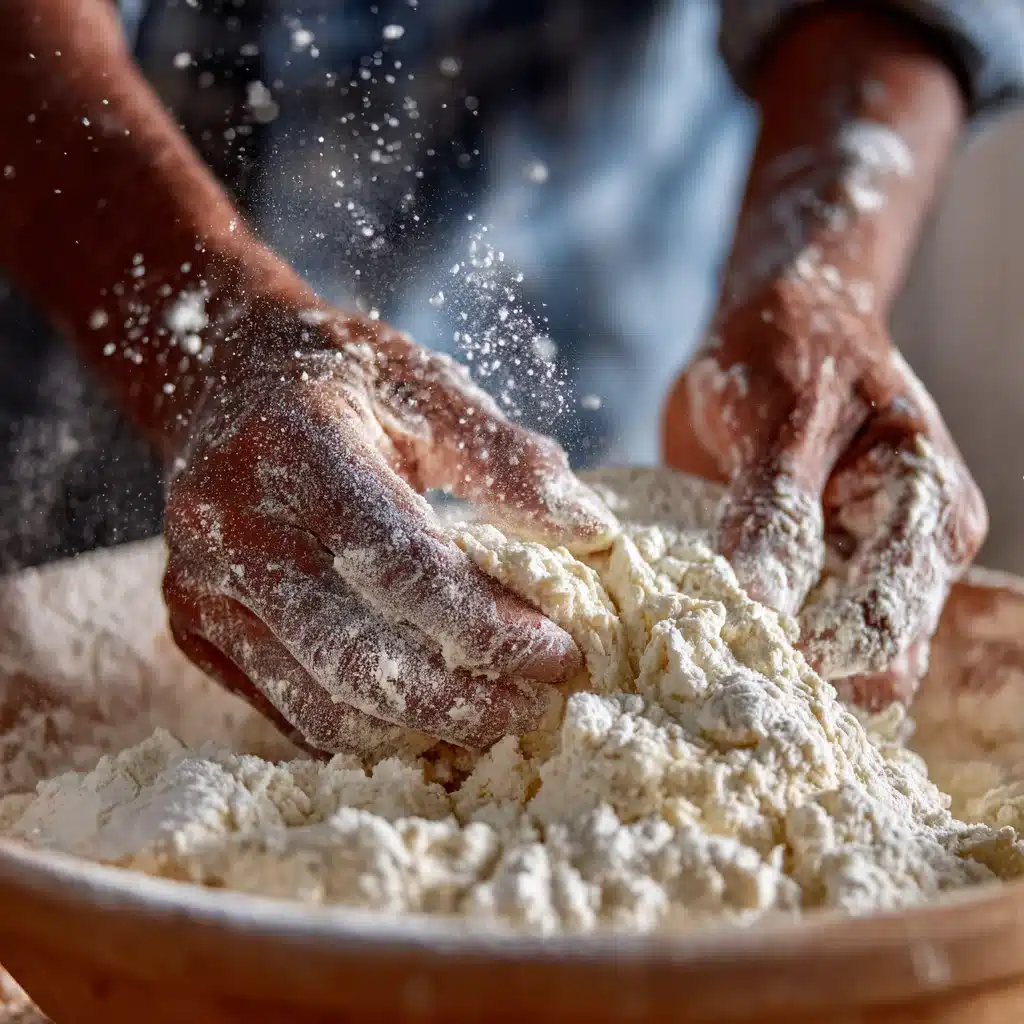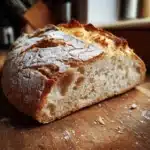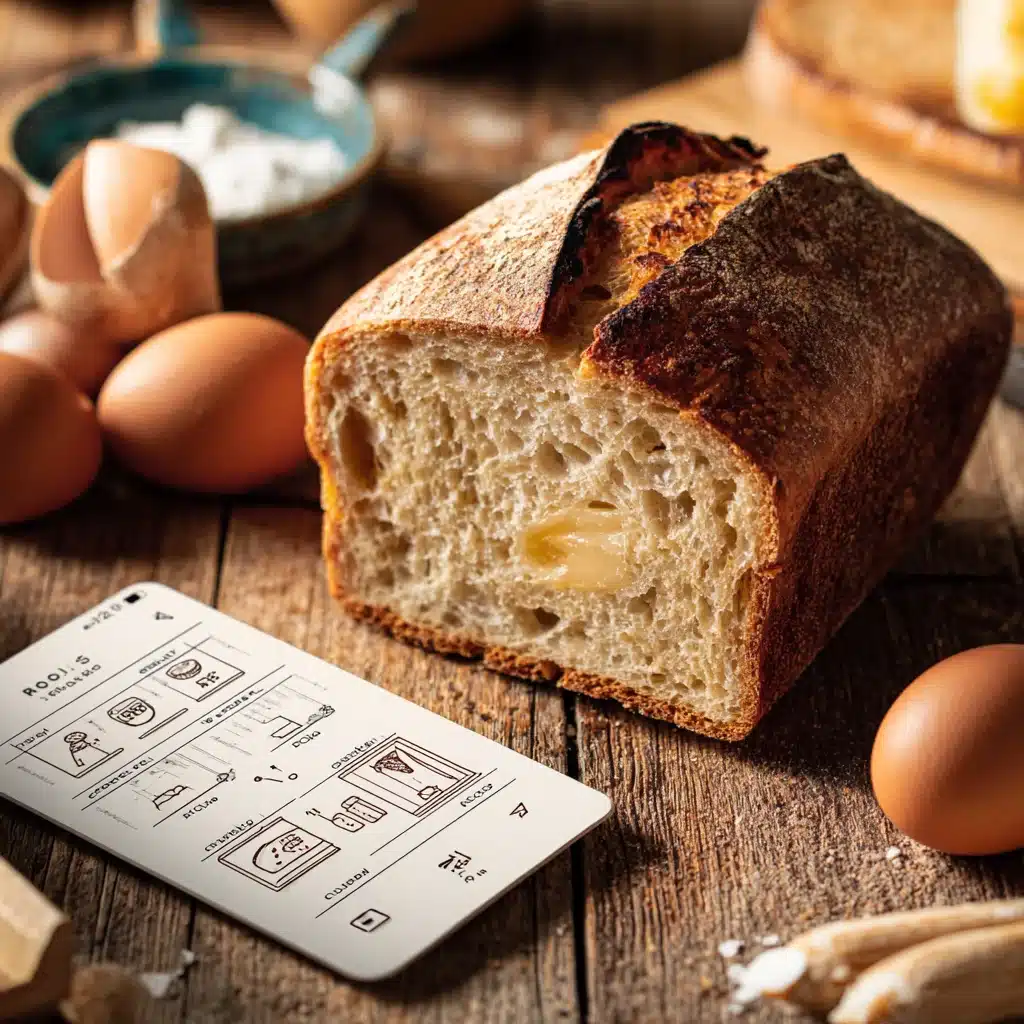Looking for a foolproof sourdough bread recipe that brings bakery-quality flavor right into your home kitchen? You’re in the right place. In this guide, we’ll walk you through the process step-by-step, from nurturing a lively starter to baking that perfectly golden crust. Whether you’re new to baking or refining your technique, this article will teach you how to make sourdough bread that’s rich in flavor and deeply satisfying. We’ll also tackle common questions like “What makes a good sourdough?” and “Why does it taste better than other bread?” Let’s mix, shape, and bake your best loaf yet.
A Love Letter to Sourdough (with Recipe)
From a Ghosted Date to a Lifelong Obsession
The very first sourdough I ever baked was a disaster. It was meant to be a romantic boule, fresh from the oven, shared with a potential soulmate. Instead, it came out like a hockey puck, and the date vanished. But that failure lit a spark. I became obsessed with understanding why three ingredients, flour, water, salt, could yield wildly different results. I named my starter Clementine, baked in wood-fired ovens, learned from grandmas who never used scales, and taught workshops from coast to coast.
Fast forward to now, in my little Mendocino kitchen, I wake to the ocean mist and the tang of fermentation. And I still believe: mistakes are part of the recipe. This sourdough bread recipe has become my trusted blueprint. With a few simple ingredients and plenty of love, anyone can bake a loaf that sings.
If you’re just getting started, check out our sourdough bread recipe for beginners and keep a jar of discard for making sourdough discard crackers. Trust me, you’ll want snacks during your bulk ferment!
What You’ll Need (Simple Ingredients, Big Results)
Here’s the base formula I use every week at Marlene & Crumb:
- 100 g active sourdough starter (bubbly and fed)
- 375 g warm water (you can go up to 400g for higher hydration)
- 500 g bread flour
- 9–12 g fine sea salt
These measurements provide a balanced hydration dough that’s easy to handle but yields an open crumb if treated well. Need more ideas to use your discard? Don’t toss it, try our sourdough discard recipes for cheesy crackers, pancakes, and more.
In the next section, we’ll cover how to mix, ferment, and shape your dough like a seasoned pro.

How to Make a Sourdough Bread Recipe That Rises and Shines
The Fermentation Stage: Letting the Dough Work Its Magic
Once you’ve mixed your sourdough bread recipe ingredients, starter, water, flour, and salt, the real transformation begins. Start by combining everything into a shaggy dough, then let it rest for 30 minutes. This crucial pause, called autolyse, allows the flour to absorb water and gluten strands to form without effort.
Next, stretch and fold the dough in the bowl every 30 minutes for about 2 hours. This replaces kneading in your sourdough bread recipe, creating strength without deflating those beautiful bubbles.
Now it’s time for bulk fermentation. This step is the heartbeat of any great sourdough bread recipe. Over 4 to 6 hours, the dough should become pillowy, with air pockets dancing just below the surface. A warm kitchen will speed things up, while a cooler space slows it down, patience here is key.

Want to troubleshoot timing or texture? Visit our expert breakdown on perfect sourdough for tips on getting your fermentation just right.
Shaping and Proofing: Building Structure in Your Sourdough Bread Recipe
After your dough has risen, gently turn it onto a lightly floured surface. Pre-shape it into a round and let it rest, uncovered, for 20 minutes. This short wait lets the gluten relax, making final shaping smoother.
Now shape the dough into a boule or batard, keeping tension across the surface for structure. Place it seam-side up in a floured proofing basket or towel-lined bowl. Cover it and cold-proof in the fridge for 8 to 12 hours.
This slow rise adds depth to your sourdough bread recipe, giving it that signature tang and chewy crumb. If you want to mix things up, try our cheese sourdough bread variation, a melty, savory twist that still follows the core technique.
In the next part, we’ll unlock the secrets to baking, scoring, and troubleshooting your loaf for bakery-style results at home.
Print
Sourdough Bread Recipe: 7 Proven Steps to Delicious Results
- Total Time: 16 hours (including fermentation)
- Yield: 1 large loaf 1x
- Diet: Vegetarian
Description
A simple, foolproof sourdough bread recipe using just flour, water, salt, and starter, perfect for beginners and pros alike.
Ingredients
100 g active sourdough starter
375 g warm water
500 g bread flour
9–12 g fine sea salt
Instructions
1. Mix starter, water, and flour. Rest 30 minutes (autolyse).
2. Add salt, mix, and perform stretch & folds every 30 mins for 2 hours.
3. Let dough bulk ferment until 50% risen (4–6 hrs).
4. Pre-shape and bench rest 20 minutes.
5. Shape into boule or batard. Cold-proof overnight.
6. Score and bake in Dutch oven at 475°F (245°C) for 20 minutes covered, then 25–30 uncovered.
7. Cool completely before slicing.
Notes
Use more water for a softer crumb (up to 400 g).
Experiment with add-ins like cheese or herbs.
Feed your starter regularly for best rise.
- Prep Time: 20 minutes
- Cook Time: 50 minutes
- Category: Bread
- Method: Baking
- Cuisine: American
Nutrition
- Serving Size: 1 slice (1/12 loaf)
- Calories: 180
- Sugar: 0g
- Sodium: 250mg
- Fat: 1g
- Saturated Fat: 0g
- Unsaturated Fat: 1g
- Trans Fat: 0g
- Carbohydrates: 38g
- Fiber: 2g
- Protein: 5g
- Cholesterol: 0mg
Keywords: sourdough bread recipe, homemade sourdough, crusty bread
Bake Your Sourdough Bread Recipe Like a Pro
Scoring and Baking: Where the Magic Happens
Once your sourdough has cold-proofed overnight, it’s ready to bake. Preheat your oven to 475°F (245°C) with a Dutch oven or baking steel inside. This ensures radiant heat and steam, both crucial to a good rise. Remove your dough from the fridge, gently invert it onto parchment, and score the top with a razor blade or lame.
Why score? It directs the oven spring upward instead of out, giving your sourdough bread recipe that beautiful bloom. A simple slash works fine, but creative patterns add personality and crust texture. Bake covered for 20 minutes, then remove the lid and bake another 25–30 until deep golden brown.
Not getting the rise you expected? Try using steam and proper preheating tips found in our sourdough focaccia method, they work wonders on all dough styles.
Once baked, let your loaf rest on a wire rack for at least an hour before slicing. Cutting too soon releases steam, making your crumb gummy. Trust me, the wait is worth it.
Avoid These Mistakes in Your Sourdough Bread Recipe
Even seasoned bakers hit roadblocks. The most common issue? Over-proofing. If your dough collapses when scored, it likely fermented too long. Under-proofing, on the other hand, gives you a tight crumb and poor rise.
Another pitfall is an inactive starter. If your starter isn’t doubling within 4–6 hours of feeding, it’s not strong enough. Our guide on bad sourdough starter covers all the signs to watch for, and how to revive it fast.
Finally, avoid using too much flour when shaping; it prevents proper surface tension. Your dough should feel tacky, not dry. Practice really does make perfect, and with each bake, you’ll learn what your sourdough dough is telling you.
In the next section, we’ll answer the most searched questions about sourdough and bring this guide to a strong finish.

FAQs, Health Perks, and How to Eat Sourdough Bread Right
Top Questions About Your Sourdough Bread Recipe, Answered
What is the secret to making good sourdough bread?
The real secret is consistency. A well-maintained starter, room temperature awareness, and understanding when dough is “ready” come with practice. Stick to your timing, trust your senses, and follow this sourdough bread recipe to learn how fermentation, hydration, and shaping impact your loaf.
Is sourdough bread better for you than other bread?
Yes, in many ways. Natural fermentation breaks down gluten and phytic acid, making it easier to digest and potentially more nutrient-available. Learn more in our deep-dive on sourdough health benefits, which covers everything from gut health to blood sugar impact.
What’s the biggest mistake you can make with a sourdough starter?
Neglect. Your starter is a living culture that thrives on regular feeding. The biggest mistake is skipping feedings or storing it improperly. Our article on bad sourdough starter outlines the warning signs, from hooch to off smells.
What are the ingredients for sourdough bread?
Every classic sourdough bread recipe has four ingredients: starter, flour, water, and salt. That’s it. No commercial yeast, no sugar, no shortcuts, just time and good microbes doing what they do best.
Serving, Storing & Creative Twists
Once your loaf cools, slice into it and take in the crumb. If you hear that delicate crunch and see irregular air holes, congrats, you nailed it! Toast it and top with smashed avocado, soft-boiled eggs, or honey and butter. Or, transform it into a grilled cheese masterpiece with melty aged cheddar.
Leftover bread? Store in a breathable bag at room temperature for 2–3 days, or slice and freeze. Never refrigerate, it dries the crumb. And don’t toss stale slices! Make sourdough croutons, French toast, or even savory bread pudding.
Want more ways to use your discard? Try sourdough discard crackers, the crispy, cheesy kind that never lasts more than a day in my house.
Conclusion
This sourdough bread recipe brings together everything I’ve learned over years of baking, teaching, and fermenting in kitchens big and small. Whether it’s your first time baking or your fiftieth loaf, remember: sourdough is a process of trust, patience, and joy.
So go ahead, mix that dough, set your timer, and bake something you’ll be proud to slice.
FAQs
Q: What is the secret to making good sourdough bread?
A: Feed your starter consistently, don’t rush bulk fermentation, and score your dough properly before baking.
Q: Is sourdough bread better for you than regular bread?
A: Yes, due to its natural fermentation, it’s often easier to digest and has a lower glycemic response.
Q: What is the biggest mistake you can make with your sourdough starter?
A: Ignoring it. Starters are alive and need routine feeding to stay active and safe.
Q: What are the ingredients for sourdough bread?
A: Active starter, bread flour, warm water, and fine sea salt.

